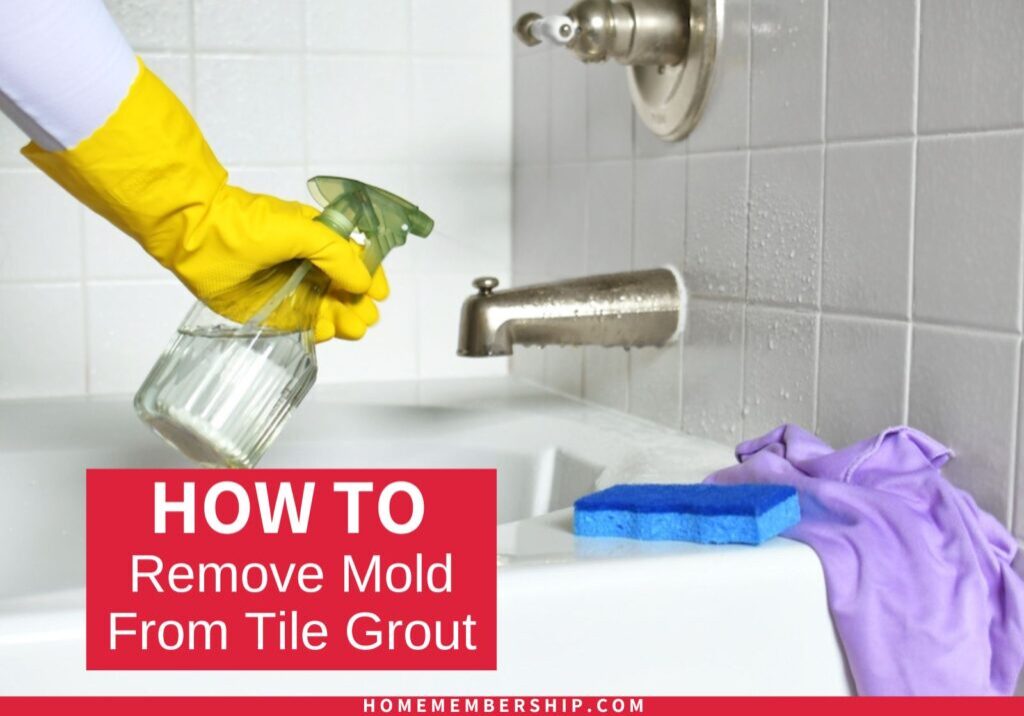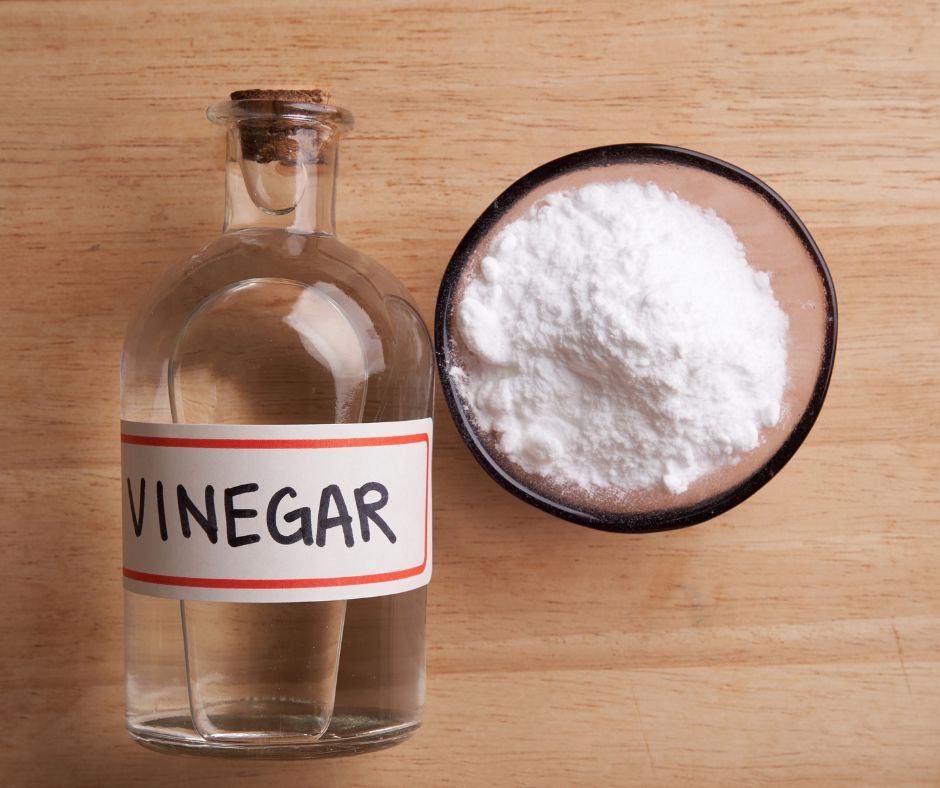How To Remove Mold From Tile Grout

Do you want to know how to remove mold in your tile grout? Check out these tips about the best ways to clean tile, prevent mold growth and keep your bathroom healthy and clean.
How to Remove Mold From Tile Grout : Best Ways to Clean Tile
Mold growth in the bathroom can be a common and frustrating issue for many homeowners. The black and pink stains in the grout lines of your shower or bathroom tiles are not only unsightly but can also pose serious health risks.
Fortunately, there are ways to tackle this problem using natural cleaning agents, ensuring both a clean home and a healthy living environment. In this article, we’ll explore the best way to remove mold from tile grout, using hydrogen peroxide, vinegar, and other readily available ingredients.

Understanding Mold Problems
Mold, particularly black mold, can thrive in damp and humid environments, making your bathroom a perfect breeding ground. Excess moisture, inadequate ventilation, and soap scum can all contribute to mold growth.
Beyond the cosmetic concerns, mold can have serious health implications, especially for those with respiratory issues or weakened immune systems.

Effective Mold Removal with Hydrogen Peroxide
- Safety Precautions: Before you begin the mold removal process, make sure to wear protective gear, such as rubber gloves and a mask, to avoid direct contact with mold spores.
- Prepare the Mixture: In a spray bottle, mix equal parts of hydrogen peroxide and warm water. This solution is a safe and effective way to clean moldy grout without resorting to harsh chemicals.
- Spray the Affected Area: Apply the hydrogen peroxide mixture directly to the moldy grout lines. Ensure that you thoroughly saturate the stained areas.
- Scrub with an Old Toothbrush: Let the hydrogen peroxide solution sit for a few minutes. Then, using an old toothbrush or scrub brush, gently scrub the moldy grout. The effervescence of hydrogen peroxide helps in breaking down the mold.
- Rinse with Warm Water: After scrubbing, rinse the area with warm water to remove any residual hydrogen peroxide and mold residue. For stubborn stains, you may need to repeat the process.

Natural Alternatives: Vinegar and Baking Soda Paste
If you prefer an alternative to hydrogen peroxide, undiluted white vinegar can be an excellent choice. Here’s how to use it:
- Create a Thick Paste: Mix baking soda with a small amount of water to create a thick paste.
- Apply to the Moldy Grout: Spread the paste onto the moldy grout lines and let it sit for about 15 minutes.
- Scrub with a Bristle Brush: Using a bristle brush, scrub the grout vigorously. The combination of vinegar and baking soda will help break down and remove the mold stains.
- Rinse Thoroughly: Rinse the area with warm water, ensuring that all paste and mold residue are removed.

Preventative Measures
Keeping Your Grout Mold Free:
To keep your grout mold-free in the future, consider these preventative measures:
Improve Ventilation:
Proper bathroom ventilation is essential for maintaining a healthy and mold-free environment. A well-ventilated bathroom helps to remove excess moisture, odors, and harmful indoor air pollutants, improving air quality and preventing the growth of mold and mildew.
To ensure effective ventilation, it’s crucial to have a working exhaust fan that efficiently removes humid air to the outside. Opening windows during and after showers can also help with air circulation.
Adequate bathroom ventilation not only enhances your comfort but also contributes to the longevity of your bathroom by reducing the risk of mold problems and promoting a fresher and more pleasant atmosphere.
Address Excess Water:
Preventing excess water from accumulating in the bathroom is essential to maintain a clean and mold-free environment. To achieve this, regularly inspect and repair any leaks in your plumbing fixtures and pipes. Make sure the seals around your shower, bathtub, and sink are in good condition, and recaulk as needed to prevent water seepage.
Additionally, always use a shower curtain or door to contain water within the shower or bathtub area, and be mindful of splashing while washing hands or brushing teeth at the sink.
Properly using bath mats to absorb water can also help. By taking these preventative measures, you can reduce the risk of water damage and the subsequent growth of mold and mildew in your bathroom.

Regular Cleaning:
Clean your bathroom grout and tiles regularly to prevent mold from taking hold in the first place.
Regular cleaning in your bathroom is of paramount importance in preventing the growth of mold. The damp and humid environment of a bathroom provides an ideal breeding ground for mold and mildew.
By consistently cleaning and scrubbing surfaces, especially grout, tiles, and shower areas, you remove the organic matter that mold feeds on and the spores it releases, making it difficult for mold to establish a foothold.
In addition, proper cleaning helps maintain a fresh and hygienic atmosphere, contributing to the overall health and cleanliness of your home. By making regular cleaning a habit, you can enjoy a mold-free and pleasant bathroom environment.
Natural Products:
Use natural cleaning agents, like tea tree oil or vinegar, as your go-to mold removal solutions. Natural cleaning products in the bathroom are highly effective at preventing mold growth for several reasons.
Unlike harsh chemicals, many natural cleaning agents, such as vinegar, baking soda, and hydrogen peroxide, are non-toxic and safe to use regularly. They also possess inherent mold-fighting properties due to their acidic or alkaline nature, making them effective at breaking down and removing mold stains.
Furthermore, natural cleaning products are eco-friendly and pose no health risks, ensuring a safer and healthier bathroom environment for your family. By incorporating natural cleaning products into your cleaning routine, you not only prevent mold growth but also contribute to a more sustainable and chemical-free household.
If you haven’t taken the proper processions and your mold problem is out of hand, you may need some more serious action to remove it.

The Power of Chlorine Bleach for Shower Grout
While natural solutions work well for most mold issues, stubborn mold stains in the shower area, especially on shower walls and tiles, may require a more potent solution. Chlorine bleach is a common and effective choice for tackling nasty mold problems. Here’s how to use it safely:
- Diluted Bleach Solution: Mix one part bleach with ten parts water in a spray bottle. This diluted bleach solution should be used cautiously and sparingly, as bleach can have health hazards and should not be used on colored grout.
- Ventilation is Key: Before applying the bleach solution, ensure the bathroom is well-ventilated. Open windows and turn on the exhaust fan to minimize exposure to fumes.
- Protective Gear: Put on protective gear, including rubber gloves, a mask, and eye protection, to shield yourself from the health hazards associated with bleach.
- Apply the Solution: Spray the diluted bleach solution directly on the moldy grout lines in the shower. Ensure the entire affected area is covered.
- Scrub and Rinse: Using an old toothbrush or a scrub brush, scrub the grout with elbow grease. Rinse thoroughly with warm water after a few minutes to remove bleach residue.
Safety and Health Concerns
Chlorine bleach should be used with caution due to its potential health hazards, particularly respiratory problems. Ensure you follow safety precautions, maintain good ventilation, and never mix bleach with other cleaning products.
The Best Option: Thorough Cleaning
For less severe mold issues and to maintain a mold-free environment, regular and thorough cleaning is the best option. To ensure you’re effectively cleaning mold and grime in your shower grout, follow these steps:
- Scrub Regularly: Regularly scrub the areas of grout in your shower with a grout cleaner, or use a mixture of warm water and a few teaspoons of peroxide with some elbow grease.
- New Grout Sealing: Consider sealing new grout during bathroom design or renovation to prevent mold growth in the first place.
- Stay Proactive: Keep an eye out for the early signs of mold, especially pink mold, in the shower area. The easiest way to combat mold is to tackle it when it’s just beginning to develop.
- Humidity Control: Invest in a dehumidifier for your bathroom to reduce humidity levels, creating a less humid environment where mold struggles to thrive.
Removing mold from shower grout is a task that requires a tailored approach, depending on the severity of the issue. While chlorine bleach is a popular choice for stubborn mold problems, it should be used with caution due to its health concerns.
Conclusion
Dealing with mold problems in your bathroom doesn’t have to involve toxic bleach or other harsh chemicals. The use of hydrogen peroxide, vinegar, and baking soda provides an effective, safe, and natural way to clean grout and remove mold stains. By following these cleaning tips and taking preventative measures, you can ensure your home remains mold-free and healthy.
The best way to keep your bathroom free from mold is through regular, thorough cleaning and proactive measures to prevent mold from forming in the first place. Your bathroom walls and shower area can remain both clean and healthy with the right cleaning solutions and safety precautions.
Remember that while these methods are generally safe, it’s essential to take safety precautions when dealing with mold. For persistent or serious mold issues, it might be a good idea to consult a professional grout cleaning service to achieve the best results without compromising your health.
I hope this helped answer your question about how to remove mold in your tile grout. While you are cleaning your bathroom, check out this guide to the best tile cleaners.



